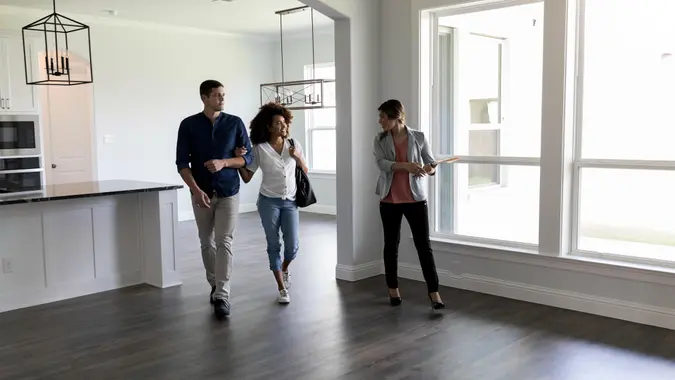I’m a Real Estate Agent: 7 Places To Avoid Buying a House in 2026

Commitment to Our Readers
GOBankingRates' editorial team is committed to bringing you unbiased reviews and information. We use data-driven methodologies to evaluate financial products and services - our reviews and ratings are not influenced by advertisers. You can read more about our editorial guidelines and our products and services review methodology.

20 Years
Helping You Live Richer

Reviewed
by Experts

Trusted by
Millions of Readers
When you’re considering a move, it’s essential to look at factors other than a home’s listing price. Cost of living, property taxes and other fees might make a city seem more expensive than it actually is. Additionally, you should be aware of how the city has performing economically, and where its future lies.
“These days, it’s not simply a case of discovering the home of your dreams — it’s ensuring the market backing that home is sound,” said Fred Loguidice, real estate expert and founder of Sell My House Fast. “Always I tell my clients: You’re not only buying real estate, you’re buying into a city’s future. And in 2026, some cities’ futures are a little uncertain.”
With housing affordability still hovering near historic lows, experts are predicting a tough road ahead for residents in some U.S. regions and downturns for some perennial housing hotspots. Here are the cities you may want to avoid buying a house in next year.
Austin, Texas
Austin’s housing market underwent an unprecedented period of price acceleration during the pandemic and is now experiencing the start of price normalization.
“Transaction data now shows inventory swelling and prices flatlining as local wage gains fail to keep up with the appreciation homeowners have come to expect,” said the owner and investor/agent at We Buy Houses in Des Moines. “This combination is frequently followed by a correction, and for a buyer in 2026, that could lead to someone getting “peaked” — having just reached top dollar right before values soften.”
Oren Sofrin, real estate investor and the founder of Eagle Cash Buyers, agreed. “Austin boomed during the COVID era because of strong migration and big-tech expansions, [and] the explosive demand for housing led to rising prices, but recently, cost has surged while demand has cooled drastically as home prices have already dropped in back-to-back years (the worst among larger metropolitan cities),” Sofrin said. “Homes are staying listed longer as there are no willing buyers.”
Rust Belt Markets
Citing places like Flint, Michigan, and Youngstown, Ohio, Loguidice said that buyers might be challenged with finding something in the Rust Belt in 2026.
“These areas are likely to see economic stagnation and declining populations,” said Loguidice. “While they may look cheap on paper, there is no or limited upside or buyer demand, which may leave homeowners in the lurch if the market continues to fall.”
New Orleans
“New Orleans has a bad problem to contend with: a slow local economy, higher flood insurance premiums and an older housing stock that’s becoming more expensive to fix,” said Loguidice. “Home prices are likely to decline by around 7% by 2026. When prices rise and demand slows, that is a recipe for long-term risk.”
Nashville, Tennessee
Adam Hamilton, CEO of REI Hub, sees an ominous future for Nashville’s housing market.
“Nashville is one city that may not be the best for buying a house in 2026,” said Hamilton. “In the past few years, it’s become a much more popular place to live. While that’s been great for the local economy, it also means that demand is outweighing supply. Nashville has better capabilities to build more housing than a lot of other big cities, but tariffs and labor shortages might make that a bit more difficult for them in 2026.”
Sun Belt Markets
Sun Belt states are ripe for a correction after years of affordability.
“Some areas of Florida, Arizona and Texas saw unsustainable growth during 2020-2022,” noted Loguidice. “In 2026, most of these are at risk of correction — especially high-investor activity cities with minimal wage growth.”
Additionally, insurance in many of these Southern warm states has become a nightmare for buyers. “Coastal areas and high-risk zones are seeing exploding insurance bills, which can quietly kill affordability,” Loguidice said.
San Francisco
Loguidice sees cracks in San Francisco’s housing foundation.
“The Bay Area, once invulnerable, now appears vulnerable,” he said. “We’re seeing tech layoffs, falling populations and through-the-roof housing prices that are pricing people out. Price corrections may not be profound, but long-term appreciation potential appears lackluster — and the entry point is still prohibitively expensive.”
San Antonio
In July, Ed Zapata, of the San Antonio Board of Realtors, said the recent 10% drop in San Antonio home sales was down to the underperforming new construction sector. “The new construction sales were down 32%, and that could be, you know, a contribution of different factors including the inventory and when they reported their sales,” he said.
A decline in new construction means more competition for existing homes, and when private firms, banks and other institutional lenders get involved, prices are being pushed up “beyond what local wage growth supports,” explained Sofrin.
He continued, “If the rates continue to rise or economic growth slows, there is risk that oversupply pressures emerge. Buyers who are relying on long appreciation might never make profit.”
More From GOBankingRates
 Written by
Written by  Edited by
Edited by 

























